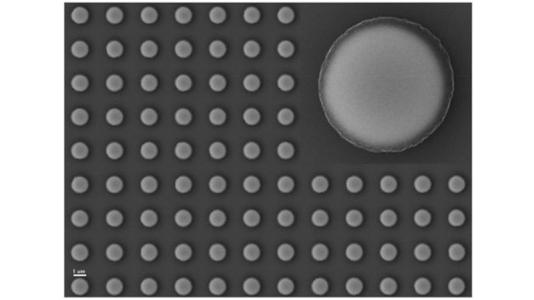
Scientific Achievement
We introduce magnetic disks with engineered properties that enhance remote detection capabilities of magnetic particle imaging far beyond what is currently available using iron oxide nanoparticles.
Significance and Impact
Engineering properties of magnetic disks can boost noise-free detection of magnetic tags in high background environments for applications ranging from biosensing and medical imaging to anti-counterfeit technologies.
Research Details
- Optical lithography and magnetron sputtering were used to create disk-shaped magnetic dots, with some variations in method depending on sample use (in vivo or ex vivo).
- Center for Nanoscale Materials resources used include optical lithography, clean room and fabrication, wet chemistry, and post-fabrication processing (lift-off).
DOI: https://doi.org/10.1039/C8NR01511B
Work was performed in part at the Center for Nanoscale Materials.
About Argonne’s Center for Nanoscale Materials
The Center for Nanoscale Materials is one of the five DOE Nanoscale Science Research Centers, premier national user facilities for interdisciplinary research at the nanoscale supported by the DOE Office of Science. Together the NSRCs comprise a suite of complementary facilities that provide researchers with state-of-the-art capabilities to fabricate, process, characterize and model nanoscale materials, and constitute the largest infrastructure investment of the National Nanotechnology Initiative. The NSRCs are located at DOE’s Argonne, Brookhaven, Lawrence Berkeley, Oak Ridge, Sandia and Los Alamos National Laboratories. For more information about the DOE NSRCs, please visit https://science.osti.gov/User-Facilities/User-Facilities-at-a-Glance.
Argonne National Laboratory seeks solutions to pressing national problems in science and technology. The nation’s first national laboratory, Argonne conducts leading-edge basic and applied scientific research in virtually every scientific discipline. Argonne researchers work closely with researchers from hundreds of companies, universities, and federal, state and municipal agencies to help them solve their specific problems, advance America’s scientific leadership and prepare the nation for a better future. With employees from more than 60 nations, Argonne is managed by UChicago Argonne, LLC for the U.S. Department of Energy’s Office of Science.
The U.S. Department of Energy’s Office of Science is the single largest supporter of basic research in the physical sciences in the United States and is working to address some of the most pressing challenges of our time. For more information, visit https://energy.gov/science.
